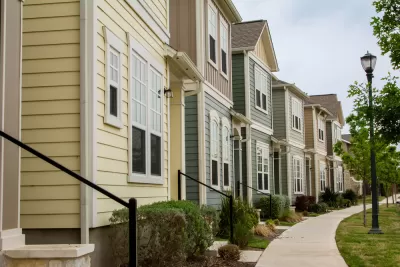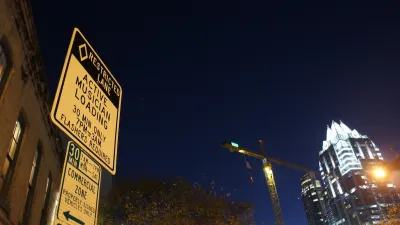The "missing middle" of housing is a concept familiar to many planners, but it's still probably unknown to most of the public. A story for Austin's NPR station could be an indication that the missing middle is entering the public consciousness.

Audrey McGlinchy kicks off the first of a two-part series about missing-middle housing and CodeNEXT—the city of Austin's ongoing zoning code update—with the story of Annette Naish, who lives in a two-bedroom, one-and-a-half-bath bought for $57,000 in the late 1990s. "Naish lives in a fourplex, or one unit in a group of four attached homes. It’s a rare breed in Austin. Some say it’s missing," writes McGlinchy.
"The term 'missing-middle' housing was coined by the head of Opticos Design Inc., the consultant helping the City of Austin with CodeNEXT, the rewrite of the land development code," adds McGlinchy, to begin the explainer of a concept usually in the purview of APA conferences and Planetizen posts.
The public is more and more aware of the issues of housing affordability around the country, so it makes sense that more and more of the public should be aware of the missing middle concept.
Researchers at the University of Southern California Price School of Public Policy recently found that the construction of missing-middle housing peaked in the 1970s and '80s. (Naish’s fourplex, for example, was built in 1972.) But since 1990, the construction of missing-middle housing has made up only about 15 percent of new housing stock in the U.S.
The article includes more on the case for missing middle housing, especially the benefits of affordability relative to the other types of housing available in Austin, and cities around the country. It should also not come as a surprise that missing middle housing is one of the goals of the code regulations proposed by the draft versions of CodeNEXT, released in February.
FULL STORY: What Is 'Missing-Middle' Housing?

Alabama: Trump Terminates Settlements for Black Communities Harmed By Raw Sewage
Trump deemed the landmark civil rights agreement “illegal DEI and environmental justice policy.”

Study: Maui’s Plan to Convert Vacation Rentals to Long-Term Housing Could Cause Nearly $1 Billion Economic Loss
The plan would reduce visitor accommodation by 25% resulting in 1,900 jobs lost.

Planetizen Federal Action Tracker
A weekly monitor of how Trump’s orders and actions are impacting planners and planning in America.

Waymo Gets Permission to Map SF’s Market Street
If allowed to operate on the traffic-restricted street, Waymo’s autonomous taxis would have a leg up over ride-hailing competitors — and counter the city’s efforts to grow bike and pedestrian on the thoroughfare.

Parklet Symposium Highlights the Success of Shared Spaces
Parklets got a boost during the Covid-19 pandemic, when the concept was translated to outdoor dining programs that offered restaurants a lifeline during the shutdown.

Federal Homelessness Agency Places Entire Staff on Leave
The U.S. Interagency Council on Homelessness is the only federal agency dedicated to preventing and ending homelessness.
Urban Design for Planners 1: Software Tools
This six-course series explores essential urban design concepts using open source software and equips planners with the tools they need to participate fully in the urban design process.
Planning for Universal Design
Learn the tools for implementing Universal Design in planning regulations.
Caltrans
Smith Gee Studio
Institute for Housing and Urban Development Studies (IHS)
City of Grandview
Harvard GSD Executive Education
Toledo-Lucas County Plan Commissions
Salt Lake City
NYU Wagner Graduate School of Public Service





























